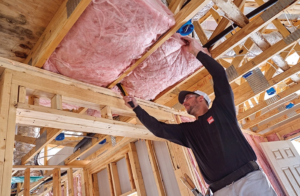Insulation Removal Perth plays a critical role in regulating your home’s temperature. If your old insulation is no longer effective, removing it can help you save money on energy bills and enjoy a more comfortable home environment.
However, if you’re considering taking on this task yourself, there are a few things to remember.

Insulation is a critical component of any home or business, improving energy efficiency and comfort while reducing utility bills. However, old or damaged insulation may necessitate removal to prevent damage to underlying structures, including mold growth and moisture issues. If left unattended, moisture can lead to structural damage and health hazards, making removing insulation a priority.
Before beginning the process of removing insulation, it is important to assess the work area and prepare for potential hazards. Ensure that the attic space is clear of stored items to avoid any accidental damage or contamination during the removal process. It is also a good idea to put on safety gear, including a respirator mask, goggles, gloves and long sleeves. This will protect you from irritation caused by fiberglass particles, dust and other irritants.
A specialized vacuum can make the process of removing blown-in insulation much easier. This type of equipment is often rented at hardware stores, and can be used to easily extract loose insulation. Make sure to wear a dust mask when using this type of equipment, and place a tarp underneath the insulation to facilitate easy clean up.
Fibreglass batt insulation is generally easier to remove, but should be handled carefully to prevent tearing or damaging the surrounding drywall and other structural components. It is also a good idea to wear long sleeves and a dust mask to minimize exposure to fiberglass particles.
Spray foam insulation is more difficult to remove, and requires extensive manual scraping and sawing to avoid damage to underlying surfaces. It is recommended to consult with or hire a professional when performing this type of insulation removal.
Once the insulation has been removed, it is important to wipe down all attic spaces and vacuum up any remaining debris. This will help to eliminate any remaining allergens and ensure that the attic is ready for new insulation. It is also important to dispose of any insulation that has been exposed to water or mold, as this can pose a serious risk for health and structural damage.
Preparation is Key
If your home is filled with old or damaged insulation, it’s time to consider removing it. This can offer a variety of benefits, including increased energy efficiency and a healthier indoor environment. Insulation removal and replacement can be performed as a DIY project or by a professional. No matter which option you choose, proper preparation is essential to ensure safety and success.
A thorough inspection of the attic space is key before starting insulation removal. This will help you identify the type of insulation as well as any potential hazards. In addition, you’ll want to make sure all entry and exit points used by vermin like mice or rats are closed off. This will prevent them from spreading harmful rodent-borne viruses throughout your house during the removal process.
If the attic space contains electrical wires or junction boxes, they must be disconnected before beginning. This will reduce the risk of electric shock or fire and allow for safe, effective insulation removal. If the attic is unfinished, it’s important to cover any areas that may be exposed with a tarp or plastic sheeting to protect them from dust and debris.
When removing attic insulation, it’s important to wear gloves and a mask to protect yourself from inhaling loose particles. This will also keep you clean while working in the attic and minimize any mess that may occur during the removal process. It’s also important to have the right tools on hand, including an insulation removal vacuum, a rake, and large waste bags. A ladder is also recommended for safe access to the attic space.
Insulation can become damaged or contaminated over time from pests, water damage, or general wear and tear. This can lead to poor indoor air quality and health issues, as well as structural problems in your home. Contaminated insulation can be a serious health hazard, which is why it’s vital to remove it and replace it with new insulation before the problem worsens. This can save you money in the long run by lowering your energy bills and reducing the risk of expensive repairs.
Identifying the Type of Insulation
It’s important to determine what type of insulation you have in your home before starting the removal process. This helps you plan the correct method of removing insulation and ensures that your health is protected throughout the process. It’s also helpful to know what the recommended insulation R-value is for your area before deciding on a replacement method.
Identifying your insulation will help you figure out the best way to remove it from the walls, attic or crawl space. Insulation comes in different forms, including blanket batts and rolls, spray foam and loose-fill cellulose. Each has its own unique set of steps to install and remove it, but they all require the same basic tools such as a hammer, flat-head screwdriver and heavy-duty garbage bags.
If you have fiberglass batt insulation in the attic, it’s a good idea to wear long sleeves, safety goggles and a face mask before working on the removal process. This will help prevent fibers from flying around the attic and causing irritation. It’s also a good idea to cover any electrical wiring and junction boxes with plastic or duct tape before beginning the process, to avoid damage and potential shocks.
For attics with loose-fill cellulose or fiberglass insulation, the preferred method is to use a vacuum machine designed for the purpose. These are typically gas-powered and come with long hoses to reach from the attic to the machine outside the home. This eliminates the need to manually remove and discard insulation, making it an effective option for minimizing energy loss.
This method is most suitable for attics that are accessible from the living space of a home, as it reduces the need to make trips back and forth to the attic while completing the job. However, if you have an attic that is difficult to access from the living room, it may be more effective to hire a professional to complete the task. Doing so will save you time and effort and ensure that the process is completed safely and properly. It will also ensure that all areas of the attic are thoroughly cleaned, including those hard-to-reach corners.
Hiring a Professional
Insulation professionals have access to specialized tools and equipment that can quickly and efficiently remove old insulation. They also stay updated on industry standards and regulations, so they can ensure your home or building meets all safety requirements.
Another advantage to hiring a professional is that they can prevent contamination. Old insulation can be contaminated by rodent droppings or other harmful substances like asbestos that could pose health risks. Professionals will take the necessary precautions to avoid any contaminants during the removal process, including screening off their work area with plastic sheeting and wearing protective gear.
Removing insulation can be a difficult and time-consuming task. This is especially true if you are working in an attic or other hard-to-reach spaces. Trying to navigate these tight and dimly lit areas can be challenging, and you might end up causing damage if you aren’t careful. Professionals will help make this process easier by using a blower and other specialized tools.
Professionals can also help prevent air leaks by removing and replacing the old insulation. This can greatly improve your energy efficiency. They will be able to identify problem areas and recommend the right solution.
The most important reason to hire a professional for insulation removal is that they will do the job safely and quickly. They will be able to provide you with the information you need about your current insulation and recommend the best course of action. In addition, they will be able to install new insulation in those hard-to-reach spaces so that you can enjoy a more comfortable home or commercial space.
Having the right type of insulation can significantly improve your comfort and efficiency. But, if the insulation is damaged or has become ineffective, it can create a host of problems that are both unsafe and costly. Professionals can safely and efficiently remove the old insulation and replace it with new material to give you the best results. They can also ensure that the new insulation is properly installed to give you optimal energy savings. Contact a local insulation specialist today to learn more about how they can help you save money and live a happier, healthier life.





